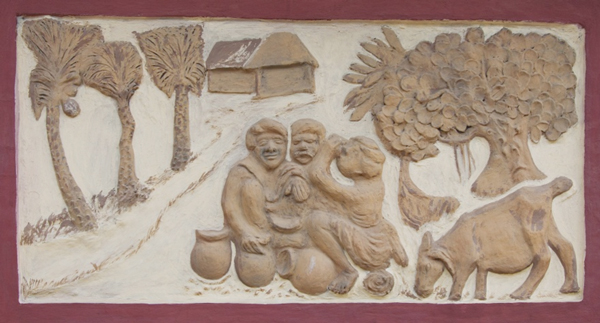
Enjoying Palm Juice
At the end of a village three Santal men sit under a Banyan tree and are happily drinking fermented juice of the tal, a commonly seen palm tree.
In the summer, the men climb on the trees to collect the refreshing juice from the tree’s buds in earthen pots. A goat is licking the discarded leaf plate from which the men eat chakhna (snacks) while drinking palm juice.
As an extension of the Santal Museum Sanyasi Lohar has started a unique project. On the outside walls of the mud huts in Bishnubati he has created murals on the life and the seasonal celebrations of the Santals. With his team Sanyasi Lohar has so far completed six large murals. […]
In this booklet we have followed the seasons from the Flower Festival or Spring Festival celebrated around March until the Sohrai or Harvest Festival celebrated in early January. Marriages normally take place in the summer, so we have placed the mural of the Marriage Reception to follow spring. We express our gratitude to the Tribal Cultural Heritage in India Foundation (Amsterdam) for funding this publication as part of our endeavour to preserve and further evolve Santal culture. […]
This booklet is an invitation to all readers to come and visit Bishnubati, walk into the Santal Museum and go around the village to view the murals in their living context.
We welcome you all!
Dr. Boro Baski
President, Bishnubati Adibasi Marshal Sangha
Source: Santals Celebrate the Seasons published by Ashadullapur Gramin Silpa & Sastha Bidhan Kendra and Ghosaldanga Bishnubati Adibasi Trust © 2014
Learn more about this unique project, view the entire series of photographs or download the eBook here: Six Murals by Sanyasi Lohar and his team >
All contents are being published with an understanding that the respective copyright owners have agreed to the license terms explained in the Creative Commons Attribution-NonCommercial-NoDerivs 3.0 Unported License. This means that no commercial use or modification of such content is permissible without written consent by their respective copyright holders.
“The tribal households traditionally had a backyard garden that had multiple, multilayered and multipurpose indigenous trees, plants, herbs, and shrubs. […] The produce from this small garden was sufficient to meet the dietary and nutrition needs of a family for an entire year.” – Learn more about food crops that are resistant to pests, grow on poor soils, flourish under changed climatic conditions and offer high nutritive value | Food distribution >>
Learn more
Ashadullapur Gramin Silpa & Sastha Bidhan Kendra | Sanyasi Lohar
Crafts and visual arts | Masks
Daricha Foundation | Deoal Chitro (wall paintings) | Homepage | YouTube channel
eBook | Background guide for education
Ghosaldanga Bishnubati Adibasi Trust
Santal music CD and DVD by Ghosaldanga Bishnubati Adibasi Trust
Santali language | eBook | A Santali-English dictionary – Archive.org
Video | Roots and Branches: The Lifeworld of an Enlightened Villager in West Bengal
Video | Santali video album “Ale Ato” (Our Village, Part 1 of 2) – West Bengal
To locate the Museum of Santal Culture in Bishnubati village (near Santiniketan) on the map seen below, open by clicking on the left button:
Tips for using interactive maps
Toggle to normal view (from reader view) should the interactive map not be displayed by your tablet, smartphone or pc browser
For details and hyperlinks click on the rectangular button (left on the map’s header)
Scroll and click on one of the markers for information of special interest
Explore India’s tribal cultural heritage with the help of another interactive map >>
